Tagged With ‘vetiver’
Geoffrey Beene
Grey Flannel
23 February, 2015
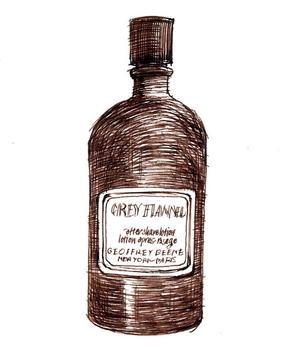 The American fashion designer Geoffrey Beene died of cancer in 2004, but Grey Flannel, the perfume he commissioned from the French fragrance company Roure in the mid-1970s, lives on, and that’s something to be grateful for, as it’s a very appealing scent – even in its current, cheaper incarnation.
The American fashion designer Geoffrey Beene died of cancer in 2004, but Grey Flannel, the perfume he commissioned from the French fragrance company Roure in the mid-1970s, lives on, and that’s something to be grateful for, as it’s a very appealing scent – even in its current, cheaper incarnation.
Created by an otherwise little-known perfumer named André Fromentin, Grey Flannel was launched in 1975 (or 1976, depending on which perfume authority you believe; I’m often surprised how much confusion there seems to be around recent perfume history). Grey flannel was Geoffrey Beene’s signature material, but fortunately that’s not what his first men’s perfume smells of.
In fact Grey Flannel smells of violets, which seems like a weirdly feminine thing to choose for men, yet the clever thing about violets – or to be more precise, about violet leaves – is that as well as smelling sweet they also have a certain woodiness, which makes their scent far less girly than, say, lily-of-the-valley or rose.
Fromentin’s skill was to take this violet-leaf fragrance (which was successfully synthesised in the early 20th century) and mix it with fresh-smelling ingredients such as galbanum (which smells like green pea-pods) and bergamot (one of the most important citrusy components of the classic men’s eau-de-cologne), but also with typical ‘masculine’ woody smells such as oakmoss (actually a kind of lichen), cedar and vetiver.
The result is a deep, rich perfume that combines sweetness and woodiness in equal measure: it’s too sweet for some, but I love it, even though it’s been reformulated in recent years, presumably with cheaper ingredients – though for once at least some of the savings have been passed on to us, the customers, for Grey Flannel is one of the best-value perfumes you can buy.
Sex and scentsibility
4 February, 2015
Are you man enough to wear Chanel No. 5? Or woman enough to splash on Azzaro Pour Homme? I have to admit that I’ve never been a great fan of cross-dressing, but it makes about as much sense to talk about ‘masculine’ and ‘feminine’ fragrances as it does to talk about ‘male’ or ‘female’ art, music or food. The fact that we divide perfumes into men’s or women’s fragrances has less to do with logic than it has to do with marketing, packaging and conventional thinking – and if you look back it’s not even that old a distinction.
Once upon a time, perfumes were perfumes, and there appears to have been little in terms of a gender divide until the early twentieth century. Men wore fragrances which today we’d regard as outrageously effete: both Napoleon and Wagner were famous for drenching themselves in scent, and Victorian gentlemen favoured sweetly scented floral perfumes alongside the ubiquitous eau de cologne. Even the words themselves – fragrance, perfume, scent – are genderless: the daft male-only term ‘after-shave’ appears only to have been dreamed up in the 1920s as a marketing wheeze. Though the expression may have made perfume sound a bit more butch and manly, all too often (in the days before male moisturiser became acceptable) it also left the more literal-minded chap with a burning face and peeling skin.
I’m not suggesting that male readers should rush out and purchase the olfactory equivalent of a pair of pink frilly knickers. Some scents (naming no names) are so insanely sweet and girly that it would be hard for even the most rugged male to get away with wearing them, but then they also tend to be the kind of perfume that smell as terrible on a grown woman as they would on any self-respecting man.
Beyond those parodies of perfume, there are remarkably few fragrances that, if you trust your nose and can brace yourself to ignore everything you’ve been told by breathless adverts and terrifyingly made-up sales assistants, are so incontrovertibly feminine or masculine as to be completely unwearable by either sex. Take one famous example. Christian Dior’s Eau Sauvage was launched in 1966 and quickly established itself as a hugely popular men’s fragrance. It’s stayed on the best-seller lists ever since, and I think most men would agree that there are few more bracing, fresh and (above all) masculine fragrances around.
I couldn’t agree more, but if you’re a fan of Eau Sauvage, next time you’re in a well-stocked perfume store, wander over to the women’s-perfume counter and have a smell of Diorella, launched just six years later and designed by the same perfumer, the legendary Edmond Roudnitska. The first time I smelled it I thought, ‘But this is Eau Sauvage!’ And it is, give or take some extra fruitiness which, you could say, gives it a slightly more girly character – though perfume guru Luca Turin regards it as ‘a perfected Eau Sauvage and one of the best masculines money can buy’.
In many ways it’s even easier the other way around, and women seem always to have been less inhibited about adopting fragrances that were originally intended to be for the opposite sex. Eau Sauvage is a classic example: whether they smelled it on their boyfriends or discovered it for themselves, women quickly recognised it as the masterpiece it is, and those in the know have been wearing it ever since. Guerlain’s superb Vetiver is, to my mind, one of the most archetypically masculine perfumes in existence, yet it, too, has long been a female favourite – the olfactory equivalent of an Yves Saint Laurent tuxedo.
More striking still are those fragrances that have crossed the gender divide more or less entirely. When Aimé Guerlain launched Jicky in 1889, it was initially bought by men; at the time its sharp, slightly catty smell was considered too overtly sexual in character for respectable women to risk wearing it. By the 1920s, though, liberated by the rise of female emancipation, women started using Jicky too, and gradually it became a ‘female’ fragrance – though a few self-confident men (Sean Connery being the most often-cited example) continue to wear it today. Chanel’s super-plush Cuir de Russie followed a similar trajectory, though it would be hard, even now, to define it as either masculine or feminine in character.
Visit the standard-issue perfume store and you’d be forgiven for thinking that we were still stuck in a world where men were men and women were women and never the twain should meet, as if history – in the world of perfume at least – had got stuck around 1955 and all the social and sexual revolutions since then had never actually happened. But society, of course, has changed, and there are encouraging signs that at least parts of the perfume industry have begun to realise that dividing fragrance along crude gender lines is a weirdly outdated thing to do. A handful of future-looking perfume brands, such as Byredo, Comme des Garçons and Escentric Molecule, already offer ‘genderless’ fragrances, and there is a growing trend for imaginative retailers to follow their lead, stocking perfumes by brand instead of dividing them into men’s and women’s scents.
Perfume customers are changing too. The majority of people may continue (for the moment at least) to accept the status quo, but for the small but growing band of perfume-lovers who are happy to think for themselves, choosing perfume on the basis of its supposed masculinity or femininity has come to seem increasingly outmoded. The trick is simply to follow your nose: to choose the perfumes you love, like the people you love, regardless of what other people might say.
Givenchy
Givenchy Gentleman
25 October, 2014
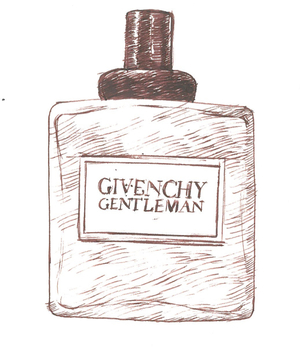
I don’t often, to be honest, feel very hippyish, but on the odd occasions when I do then Givenchy Gentleman suits my mood very well, with its distinct patchouli smell.
The original version was released in 1974 to tie in with couturier Hubert de Givenchy’s first ready-to-wear boutique, and it must have seemed bang on trend back then. Created by Paul Lèger (who also had a hand in the big-selling women’s perfume, Anaïs Anaïs), it was quickly hailed as a masterpiece, but has since been turfed out of the perfume pantheon, not least because the original recipe was fiddled about with a few years ago – presumably to save money and comply with tighter industry regulations.
If Givenchy Gentleman contained nothing but patchouli I wouldn’t be writing this review, but Lèger’s long list of ingredients included cinnamon, vetiver and something that approximates to the smell of leather. The last two in particular give the scent its appealing earthy, masculine character and stop it from being too sweet or cloying; it also contains (or contained) a whole host of other fragrance ‘notes’, including lemon and bergamot, tarragon, cedar and sandalwood, which added to Givenchy Gentleman’s complexity and depth.
It may not be the perfume that once it was, but I haven’t yet found a more wearable patchouli-based scent for men, though I have to admit that the latest version (has it been reformulated again?) starts well but then develops a slightly sour, unattractive undertone on the skin.
It’s been repackaged too, and the latest bottle has such a cheap label that if I didn’t know better I’d be inclined to suspect I’d been sold a dodgy knock-off from a market stall. Sadly it seems that the knock-off effect is entirely Givenchy’s own.
Guerlain
L’Homme Idéal
11 October, 2014
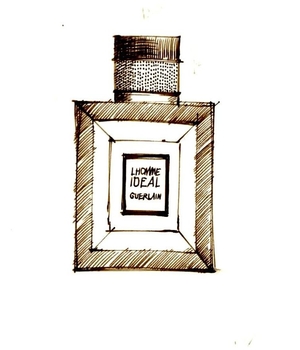 I have before me a bottle of Amaretto liqueur, which I’m tempted to drink, though seeing as it’s ten in the morning I probably shouldn’t. I also have a bottle of the latest men’s perfume from Guerlain, L’Homme Idéal, which you’ll be relieved to hear I won’t be drinking either.
I have before me a bottle of Amaretto liqueur, which I’m tempted to drink, though seeing as it’s ten in the morning I probably shouldn’t. I also have a bottle of the latest men’s perfume from Guerlain, L’Homme Idéal, which you’ll be relieved to hear I won’t be drinking either.
The reason for this conjunction is that several reviews of L’Homme Idéal have suggested that it smells distinctly like Amaretto, so I’m testing whether they do – and the answer is that, side by side like this, they don’t. Amaretto smells far sweeter and more almondy, with a touch of bitter almonds that L’Homme Idéal lacks.
All the same, the Amaretto comparison should give you some idea of L’Homme Idéal’s character: burnt-sugar sweet and, yes, really quite almondy. It’s a smell that won’t appeal to every man (though I suspect a lot of women will like it), and in fact the perfume hasn’t exactly been greeted with universal acclaim, though personally I rather like it.
Launched in June 2014, L’Homme Idéal was created by Thierry Wasser, who has been the company’s in-house perfumer since 2008; I’ve reviewed one or two of his other perfumes, including Guerlain Homme l’eau Boisée and the wonderfully refreshing Cologne du Parfumeur. Its ingredients include orange, rosemary, cedar and vetiver, but the two that most people pick up on are tonka beans and almonds, with a bit of leather thrown in.
Tonka beans are used in a wide range of perfumes, and they have a warm, slightly sweet smell, which many people find reminds them of food, especially chocolate and vanilla. The scent of almonds is less often used (though James Heeley’s fine but painfully overpriced L’Amandière smells of almost nothing else), but they’re what give L’Homme Idéal its distinctly foody, burnt-sugar smell.
Luckily – from my point of view at least – L’Homme Idéal isn’t nearly as sickly-sweet as Thierry Mugler’s revolting Angel, or even as cutesy sweet as Black XS for Men from Paco Rabanne. Sweet smells, like sweet tastes, have something a bit childlike and unsophisticated about them, but Thierry Wasser has toned the sweetness down here by surrounding the tonka beans and almonds with the smells of freshly-sawn wood and new leather, as well as a hint of dry, earthy vetiver.
All in all this is a nice enough fragrance, but it’s a bit too muted and polite to really stand out for me. That may well be intentional, since it seems to be squarely aimed at the big middle market, whose buyers are not widely considered to be particularly adventurous or sophisticated. Mind you they’re also considered to be virtually illiterate, if Guerlain’s French-pretentious marketing guff is anything to go by.
Yes, it’s same old tired perfume bollocks yet again: ‘The ideal man is a myth. His fragrance, a reality. Guerlain decodes men’s aspirations and creates for them a concentrate of ideal. The ideal fragrance? Smart, handsome, strong. Three adjectives, three accords for this fresh woody fragrance that will trigger your full potential.’ As a copywriter myself I’d be ashamed to have written that, though I’m sure whoever did write it was handsomely paid. (The box, incidentally, sports a typographical car-crash that seems to read, ‘Be You. No Need to Anymore Have Your Fragrance.’ Got that? Me neither.)
Still, the smell is nice enough, and the bottle is actually far better than most: a chunky glass square with (according to Guerlain) ‘radical’ matt black lacquer sides and a crisply detailed cap that apparently ‘borrows its guilloché detailing from the world of watchmaking.’ I think they should have borrowed the cap from an Amaretto bottle, but there you go.
Hermès
Vétiver Tonka
18 August, 2014
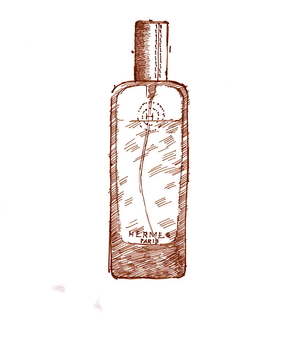 Like several other major perfume and fashion brands, Hermès has, in recent years, organised its range of perfumes into a number of different groups. I’m guessing that this is partly to help them refine their message for different segments of the market, but I also wonder whether it has something to do with their in-house perfumer, Jean-Claude Ellena, trying to bring order to a rather disparate collection of scents, in the way that a newly appointed curator might attempt to impose order on a rather muddled art collection.
Like several other major perfume and fashion brands, Hermès has, in recent years, organised its range of perfumes into a number of different groups. I’m guessing that this is partly to help them refine their message for different segments of the market, but I also wonder whether it has something to do with their in-house perfumer, Jean-Claude Ellena, trying to bring order to a rather disparate collection of scents, in the way that a newly appointed curator might attempt to impose order on a rather muddled art collection.
Whether intentionally or not, the groups have been divided in a way that reflects the gradual shift away from gendered to genderless scents, with most of the pre-Ellena perfumes being assigned, in the old-fashioned way, to either women or men (men getting Bel Ami, Equipage and Terre d’Hermès). By contrast most of the more recent scents are categorised by type, not gender, and described as ‘for sharing’ – currently five in Les Colognes collection, four in Les Jardins and eleven in the much more expensive Hermessences range, leaving Eau d’Hermès and Voyage d’Hermès standing on their own.
I’m guessing that the mass-market scents – Voyage and Terre d’Hermès – bring in most of the cash, but what seems to interest Hermès most (and, by extension, Jean-Claude Ellena) are the Hermessences: there are already more of them than there are in any other range, and they’re the only fragrances for which the company does its own in-house PR. They’re also almost twice the price of other Hermès scents: £161 for a 100ml eau-de-toilette as opposed to £73-£80 for a 100ml eau-de-toilette from any of the other groups.
Given how much they cost, you’d expect the Hermessences to be more unusual and have more staying-power than Hermès’ other perfumes, and at least in the case of Vétiver Tonka, that seems to be true. One often-repeated criticism of Jean-Claude Ellena is that the perfumes he creates tend towards the light and evanescent – delicate compositions that disappear all too quickly on the skin. Some people might regard that as a good thing, but as a value-for-money Yorkshireman I want to get some bang for my buck.
Vétiver Tonka certainly lasts, so that’s a good start. It’s also unusual, which for me is another plus – so many perfumes smell almost identical these days. But unusual doesn’t always mean attractive, or even wearable – just smell the amazing Bulgari Black, which is a brilliant scent, but also almost unwearable, at least outside a nightclub. Vétiver Tonka certainly isn’t in that league, but nor does it fit into an easily recognisable ‘normal’ category of scents.
Vetiver, of course, is a classic ingredient of many perfumes aimed at men: extracted from the roots of a tropical grass, it smells earthy and dry, but also fresh; it has the added advantage of being extremely long-lasting, and it can enhance the longevity of other ingredients too. The vetiver that Jean-Claude Ellena has used here, though, is a smoother, less rough-edged extract, which makes the perfume smell perhaps a little more feminine than I’d normally expect.
Tonka – the perfume ingredient, not the toy company – comes from the beans of the cumaru tree, Dipteryx odorata, which grows in Central America and, like laburnum and wisteria, belongs in the pea family. These beans yield coumarin, a chemical that was often used as a cheaper substitute for vanilla; coumarin also smells a bit like cinnamon, almonds or cloves, all of which I get traces of in Vétiver Tonka.
In many ways this is a perfume that does what it says on the tin, for if you can imagine the earthy smell of vetiver mixed with the foody smell of tonka (which many people find slightly chocolatey, probably because of its association with chocolate), then that’s pretty much how Vétiver Tonka smells. The vetiver helps it last all day, but what I mostly smell is the tonka, doubtless blended with many other things – there’s a gentle nuttiness, a bit like rum or sherry, or even a kitchen in the middle of baking day.
When I asked my mum what she thought of it she said, ‘It’s a very nice smell, but it doesn’t really smell like a perfume,’ and I think that pretty much sums it up. Not something you’d necessarily want to adopt as a signature scent, but a quality perfume to try if you fancy smelling a bit out of the ordinary. It also comes in a very nice Hermès box (with a rather cheap-looking cloth bag inside), and the clear-glass bottle – cleverly suffused with pale green – is satisfyingly chunky, with a stitched-leather cap, though whether all that makes it £161 I’m still not sure.
Aramis
Aramis 900
9 June, 2014
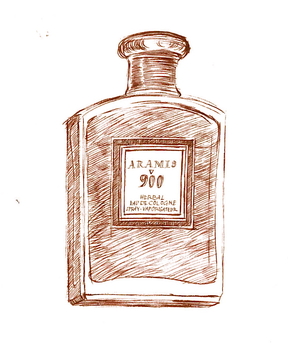
Aramis is one of those mid-market brands that seems to have been around for ever, and for that reason it’s often overlooked or, worse, looked down upon. Which is, I think, a shame, because there are some classic men’s perfumes in the range.
The all-men’s brand was launched in 1964 by Estée Lauder and her husband Joseph, with the eponymous Aramis (which I’ve reviewed here) as the first fragrance in the range. Though I’d always assumed the brand and the perfume were named after the character in The Three Musketeers, legend has it that it actually commemorates an obscure town in Armenia, which these days is transliterated as Yeremes. It sounds like a leg-pull, but then we’re also told that the Lauders were working with an Armenian designer at the time by the name of Arame Yeranyan, so you never know; I’ll let you know if I can get a definitive answer out of somebody.
Whatever the truth of the matter (and the perfume industry’s relationship with historical fact can sometimes be rather shaky), Aramis was a big success, and in 1973 it begat Aramis 900. Like the original Aramis it was created by Bernard Chant, a brilliant French perfumer who loved spicy, leathery fragrances, and it’s very much along those lines.
In fact, as it’s often been pointed out, if Aramis 900 hadn’t been marketed for men, it would have worked just as well as a woman’s scent – a good example of the obvious but too rarely grasped fact that in itself perfume has no gender. Just smell Clinique’s classic woman’s perfume, Aromatics Elixir, and you’ll see what I mean: it was also created by Bernard Chant and to many people smells identical to Aramis 900.
Aramis 900 is a deep, spicy, complicated scent, which makes most contemporary offerings smell weedy and washed-out by comparison. Today you’d only expect to find a men’s fragrance smelling this rich and complex in an expensive ‘exclusive’ range like Tom Ford or Armani Privée, but when it was launched it was aimed squarely at the middle market: these were not expensive perfumes.
Like the majority of other men’s perfumes, Aramis 900 includes lemon and bergamot, but among its more persistent and powerful ingredients are carnation, orris (iris) root, geranium, oakmoss, patchouli and vetiver, as well as rosewood oil, the natural form of which comes from an increasingly threatened rainforest tree, Dalbergia nigra.
Unlike most modern men’s perfumes, though, Aramis 900 has a predominantly floral scent, which to me smells like a mix of clove-scented carnation and old-fashioned rose. Though floral fragrances were popular with Victorian men, in 20th-century western culture they came to be thought of as ‘girly’, though for no particularly logical reason as far as I can see.
Luckily that didn’t stop perfumers from using floral ingredients in men’s perfumes, but in the case of Aramis 900 those flowery scents are brilliantly disguised by all sorts of other things, including a faintly ‘dirty’ smell that adds an oddly sexy extra to the mix. The forest-floor oakmoss and vetiver also stop it smelling sweet, while the carnation (despite being a flower) gives it the same kind of peppery spiciness that you can smell in Chanel’s Egoïste.
The amazing thing, to me, is that perfumes like Aramis 900 have been so cheap for so long, but in 2009 it seems to have dawned on Estée Lauder Inc what they had on their hands, and six perfumes in the Aramis range – including Aramis 900 – were relaunched and repackaged in matching bottles. Now priced at a less mass-market £60 and titled a ‘Gentleman’s Collection’, presumably the hope is that men who liked one fragrance might go on to collect the rest. Given the quality of most men’s fragrances today I’d say that wouldn’t be a bad idea.
Chanel
Sycomore
28 May, 2014
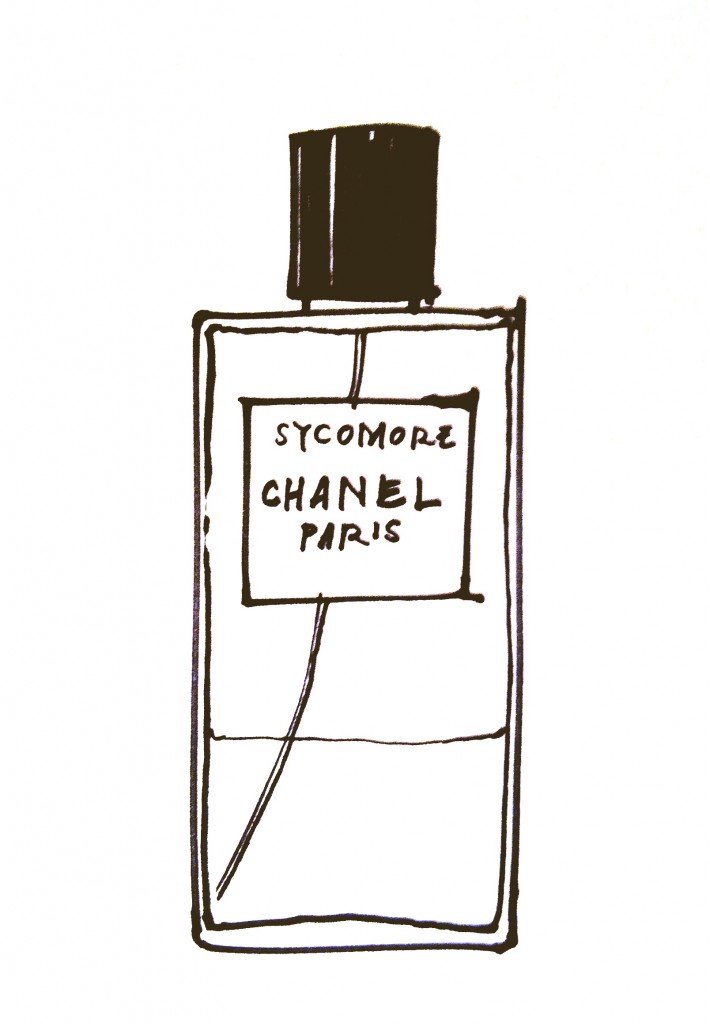 Until recently, Sycomore was one of the most extraordinary perfumes that I know (see note, below). OK, its name looks like a misspelling of sycamore, a tree that – in Britain at least – no right-minded person would name a fragrance after. Sycamores, after all, are as common as muck, breed like rabbits and are often looked down on by ecologists as they’re not even native trees.
Until recently, Sycomore was one of the most extraordinary perfumes that I know (see note, below). OK, its name looks like a misspelling of sycamore, a tree that – in Britain at least – no right-minded person would name a fragrance after. Sycamores, after all, are as common as muck, breed like rabbits and are often looked down on by ecologists as they’re not even native trees.
Acer pseudoplatanus, to give the tree its proper botanical name, is also responsible for many of those deeply irritating ‘leaves on the line’ excuses that railway companies give out each autumn to explain why their trains are running late. Worst of all, from a perfume perspective, they don’t even really smell of much, though their leaves do have the faintest leathery scent and their wood, once dried enough, burns with a pretty generic woodsmoke smell.
So is Sycomore just an example of misguided marketing, like Ralph Lauren’s dreadfully named Glamourous? Actually, no. Coming from arguably the world’s most tightly policed brand, its name will have been very carefully considered – and actually it almost certainly refers not, as I’d initially thought, to Acer pseudoplatanus at all but to a rather more exotic tree, the so-called Sycomore fig.
Ficus sycomorus (to use its Latin name) is a large, spreading tree that grows across central Africa and the Middle East, where its heavy shade is much appreciated; it was known to the Egyptians as the Tree of Life. It’s a tree I haven’t sniffed, but my guess is that it shares at least some of the dry, green, slightly fruity scent that we know from other varieties of fig – though ironically there’s only the faintest hint of figginess in Sycomore.
Anyhow, enough about the name. What makes Sycomore extraordinary, for me, is a trick it seems to be able to do that no other perfume I’ve come across seems to be able to do. This is to smell like two completely different scents, depending on whether you smell it close up or at a distance. Up close it has the strong, earthy, pleasantly bitter scent of vetiver, the root of an Indian grass that’s related to lemongrass and citronella. It’s also grown commercially in the Caribbean, and apparently Chanel’s super-high-quality vetiver originated in Haiti.
Vetiver is usually classed as one of the great masculine fragrances, presumably because of its bracing bitterness and lack of cloying sweetness; it’s certainly not a flowery smell. But it also has a warmth and – get this – a touch of smokiness that gives it extra depth and complexity, especially when it’s surrounded by such a delicious cushion of other scents, which mix smokiness with a slightly sweeter touch of fruit. Vetiver is also famous for its staying power, and a spritz of Sycomore can last you all day.
It’s the added fruitiness that, on occasion, one gets a whiff of when someone wearing Sycomore strolls by, and then it’s like a different, warmer, sweeter fragrance altogether, with hardly a hint of the vetiver that dominates the perfume on the skin. If it’s an intentional trick I’m in awe, though it seems perfectly possible, given that Sycomore was created by Chanel’s chief nose Jacques Polge in collaboration with Christopher Sheldrake, the legendary British perfumer who has been Chanel’s director of research and development since 2005.
Like the other fragrances that belong to Les Exclusifs de Chanel, Sycomore costs about twice as much as your average perfume, but it does come in a typically (for Chanel) handsome bottle, beautifully presented in a chunky white-and-black box. The hidden magnet in the heavy black cap, ensuring that the iconic twin Cs of the Chanel logo always end up perfectly aligned, is a particularly nice touch, even if it has since been adopted by one or two other brands.
Though it’s a classically masculine scent Sycomore is (quite rightly) marketed as a unisex fragrance, and like most men’s perfumes it can smell wonderful on a woman. Yet what I love most is that, from the very first sniff, it has a wonderful feeling of luxury, quality and depth, which are things that are all too often lacking in other perfumes. And who could resist its baffling cleverness, like a cryptic crossword in scent?
Autumn 2016 update. Oh dear: evidently Sycomore hasn’t been a commercial success, as Chanel have recently ‘updated’ it, and now – minus the fruitiness that made it so unusual – it’s a perfectly pleasant, fairly straight-up vetiver. From being unique it’s become one of many. Such a shame – another great perfume gone.
Angela Flanders
Artillery No. 4
10 March, 2014
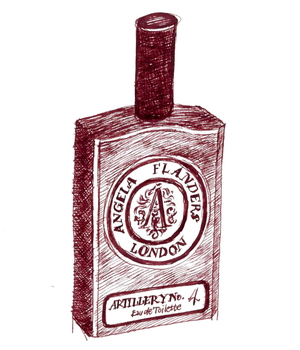 Picked up for a fiver in a Vogue House charity sale, entirely on the look of the bottle (you had to move fast), Artillery No. 4 turns out to be an unexpected treat. Launched in 2012, it was created by Angela Flanders, an English perfumer whose scents have an appealingly home-made quality which extends, in this case, to the label’s hand-written ‘4’.
Picked up for a fiver in a Vogue House charity sale, entirely on the look of the bottle (you had to move fast), Artillery No. 4 turns out to be an unexpected treat. Launched in 2012, it was created by Angela Flanders, an English perfumer whose scents have an appealingly home-made quality which extends, in this case, to the label’s hand-written ‘4’.
The name is a nod to the location of her shop in Artillery Passage, a splendidly Dickensian alleyway just east of the City of London. But it’s also a good choice for this particular perfume, as No. 4 has a whiff of gunpowder about it, or at least a hint of bonfire-night smoke.
It’s actually based around vetiver, the earthy-smelling tropical grass root that gives a bracingly bitter character to many classic men’s fragrances, but for once vetiver plays a fairly discreet background role. The first thing I smell, apart from that smokiness, is lavender (lots of it), another classic male scent – this is a very masculine fragrance. It’s spicy without being overpowering, with a gentle touch of orange provided by bergamot oil.
I like Artillery No. 4 a lot, though it’s not particularly long-lasting, which is unusual in a perfume that’s based on vetiver. It also comes in a simple yet attractive bottle, which is more than can be said for so many fragrances these days. How nice to stumble across a fragrance that deserves to be better known.
Guerlain
Guerlain Homme l’eau Boisée
18 January, 2014
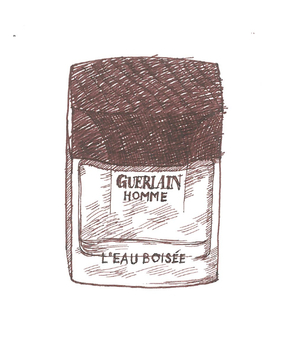 Few perfume companies have such a great heritage (and so many perfumes) as Guerlain, which is presumably why the luxury behemoth LVMH bought it in 1994. Founded in Paris in 1828 by Pierre-François Guerlain, it reached its apotheosis in the late nineteenth and early twentieth century under Pierre-François’ grandson Aimé (who concocted the wonderful Jicky in 1898) and Aimé’s nephew, Jacques Guerlain.
Few perfume companies have such a great heritage (and so many perfumes) as Guerlain, which is presumably why the luxury behemoth LVMH bought it in 1994. Founded in Paris in 1828 by Pierre-François Guerlain, it reached its apotheosis in the late nineteenth and early twentieth century under Pierre-François’ grandson Aimé (who concocted the wonderful Jicky in 1898) and Aimé’s nephew, Jacques Guerlain.
One of the greatest perfumers of all time, Jacques created a whole series of legendary fragrances between 1906 and 1925, whose names are almost as alluring as the scents themselves: Après l’Ondée in 1906, L’Heure Bleue in 1912, Mitsouko in 1919, Shalimar in 1925, and Vol de Nuit in 1933.
Jacques’ grandson, Jean-Paul Guerlain, continued the family tradition, creating many superb fragrances of his own, for women and for men, including three of my own personal favourites – Vétiver (1959), Habit Rouge (1965) and Héritage (1992). But his reign ended sadly: after the Guerlains sold out to LVMH, Jean-Paul became just one of Guerlain’s hired hands, and in 2010 even his post-retirement role as a consultant was terminated after he made a casually racist remark on French television.
I’ll return to some of my own favourite Guerlain perfumes in future reviews, but I’ve recently been given, very generously, a bottle of Guerlain Homme L’eau Boisée, and as I rather like it I thought it would be good to feature something that was only released in 2012.
L’eau Boisée was created by Thierry Wasser, the Swiss-born perfumer who, before he took over from Jean-Paul Guerlain in 2008, worked for the multinational fragrance company Firmenich and was responsible for perfumes as diverse as Dior’s Addict, Diesel’s Fuel for Life and Kylie Minogue’s Darling.
Wasser’s original Guerlain Homme was released, to mixed reviews, the same year that he joined the company in-house. With a nice touch of wit, it’s based on the smell of a mojito, the Cuban cocktail whose ingredients include white rum, spearmint leaves and lime juice, but it’s been generally described as a fairly mass-market men’s fragrance – perfectly wearable, at least, but hardly up there with Habit Rouge or Jicky.
Since then, impelled by perfume retailers’ insatiable (and ultimately self-defeating) demands for novelty, Wasser has so far created three further versions of Guerlain Homme: Intense (2009), L’eau (2010) and L’eau Boisée. This last is a soft, woody fragrance, whose initial fresh scent of lime fades fairly quickly, to be followed by the warm scent of cedar wood and the pleasantly earthy smell of vetiver (Wasser uses a special vetiver from Tamil Nadu in southern India, apparently, rather than the more usual variety from Haiti or Réunion).
I can’t smell rum in L’eau Boisée, but to me it does have a faint but not unpleasant smell of celery, and a faintly sweaty (but again not unpleasant) scent that reminds me of a bottle of Penhaligon’s Hammam Bouquet that I used up years ago – must go and have a sniff to compare.
Would I rush out and buy a bottle? I’m not sure I would, as it’s hardly a groundbreaking scent; but as new perfumes go it’s both pleasant and rather refined, the kind of thing you could safely buy for an uncle or a friend. I’d be interested to know what you think.
The job-interview fragrance
20 July, 2012
I was walking down Shaftesbury Avenue last week when I noticed, just ahead of me, a young woman standing outside the lobby of some fairly swanky offices. As I got closer, she reached into her handbag and produced one of those slimline canisters of scent, which she proceeded to spray all over herself like a crop duster until a cloud of foul-smelling perfume drifted across the entire street.
It was only at this point that it struck me how dressed- and made-up she was, and the thought crossed my mind that she must be going for an interview – in which case pity the poor interviewers. I spent the rest of the morning wondering what effect reeking of bad perfume might have on one’s chances.
If there’s a moral to the story (other than move fast if you ever see anyone getting a scent spray out of their bag), perhaps it’s that perfume, if it doesn’t exactly maketh the man, certainly maketh a bigger impression than one might imagine. I can’t imagine many blokes carry their favourite fragrance around with them, but choosing the right perfume for an important occasion is just as crucial for a man as for a woman. Get it wrong and you could ruin your chances.
Discretion may be the better part of valour, but it’s also a good guide when choosing a perfume for a job interview. The easy way out would be not to wear perfume at all, but wearing a really good but understated classic fragrance does wonders for one’s self-confidence – and can also make a good impression on other people, often without them even knowing why.
As far as fragrances go, it’s hard to beat something that embodies old-fashioned masculinity, such as Guerlain’s Vetiver. For something a bit warmer I’d choose Chanel’s Pour Monsieur, not least because it’s actually quite hard to overdo it. It’s a lovely discreet perfume, but if you’re feeling flush then the same company’s delicious, slightly lavendery Eau de Cologne is even finer – though as someone said to me the other day, ‘It’s a lovely cologne, but if I was going to spend that much money I’d buy something a bit more unusual.’
Fair enough – but surely it’s better to invest in a great fragrance than saving your money and smelling like fabric conditioner? Just remember that poor deluded girl on Shaftesbury Avenue. I wonder if she got the job?